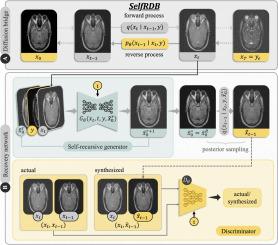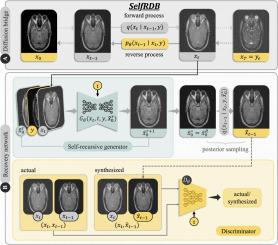Self-consistent recursive diffusion bridge for medical image translation
IF 11.8
1区 医学
Q1 COMPUTER SCIENCE, ARTIFICIAL INTELLIGENCE
引用次数: 0
Abstract
Denoising diffusion models (DDM) have gained recent traction in medical image translation given their high training stability and image fidelity. DDMs learn a multi-step denoising transformation that progressively maps random Gaussian-noise images provided as input onto target-modality images as output, while receiving indirect guidance from source-modality images via a separate static channel. This denoising transformation diverges significantly from the task-relevant source-to-target modality transformation, as source images are governed by a non-noise distribution. In turn, DDMs can suffer from suboptimal source-modality guidance and performance losses in medical image translation. Here, we propose a novel self-consistent recursive diffusion bridge (SelfRDB) that leverages direct source-modality guidance within its diffusion process for improved performance in medical image translation. Unlike DDMs, SelfRDB devises a novel forward process with the start-point taken as the target image, and the end-point defined based on the source image. Intermediate image samples across the process are expressed via a normal distribution whose mean is taken as a convex combination of start-end points, and whose variance is controlled by additive noise. Unlike regular diffusion bridges that prescribe zero noise variance at start-end points and high noise variance at mid-point of the process, we propose a novel noise scheduling with monotonically increasing variance towards the end-point in order to facilitate information transfer between the two modalities and boost robustness against measurement noise. To further enhance sampling accuracy in each reverse step, we propose a novel sampling procedure where the network recursively generates a transient-estimate of the target image until convergence onto a self-consistent solution. Comprehensive experiments in multi-contrast MRI and MRI-CT translation indicate that SelfRDB achieves state-of-the-art results in terms of image quality.


用于医学图像翻译的自洽递归扩散桥
扩散去噪模型(DDM)由于其训练稳定性和图像保真度高,近年来在医学图像翻译中得到了广泛的应用。ddm学习多步去噪变换,逐步将随机高斯噪声图像作为输入映射到目标模态图像作为输出,同时通过单独的静态通道接收源模态图像的间接引导。这种去噪变换与任务相关的源到目标模态变换明显不同,因为源图像由非噪声分布控制。反过来,ddm在医学图像翻译中可能遭受次优源模态引导和性能损失。在这里,我们提出了一种新的自一致递归扩散桥(SelfRDB),它在其扩散过程中利用直接源模态引导来提高医学图像翻译的性能。与ddm不同,SelfRDB设计了一种新颖的前向过程,将起点作为目标图像,并根据源图像定义终点。整个过程中的中间图像样本通过正态分布表示,其平均值取为起点和终点的凸组合,其方差由加性噪声控制。与常规扩散桥规定在起点和终点的零噪声方差和过程中点的高噪声方差不同,我们提出了一种新颖的噪声调度,其方差向终点单调增加,以促进两种模式之间的信息传递并增强对测量噪声的鲁棒性。为了进一步提高每个反向步骤的采样精度,我们提出了一种新的采样过程,其中网络递归地生成目标图像的瞬态估计,直到收敛到自一致解。在多对比MRI和MRI- ct翻译方面的综合实验表明,SelfRDB在图像质量方面取得了最先进的结果。
本文章由计算机程序翻译,如有差异,请以英文原文为准。
求助全文
约1分钟内获得全文
求助全文
来源期刊

Medical image analysis
工程技术-工程:生物医学
CiteScore
22.10
自引率
6.40%
发文量
309
审稿时长
6.6 months
期刊介绍:
Medical Image Analysis serves as a platform for sharing new research findings in the realm of medical and biological image analysis, with a focus on applications of computer vision, virtual reality, and robotics to biomedical imaging challenges. The journal prioritizes the publication of high-quality, original papers contributing to the fundamental science of processing, analyzing, and utilizing medical and biological images. It welcomes approaches utilizing biomedical image datasets across all spatial scales, from molecular/cellular imaging to tissue/organ imaging.
 求助内容:
求助内容: 应助结果提醒方式:
应助结果提醒方式:


